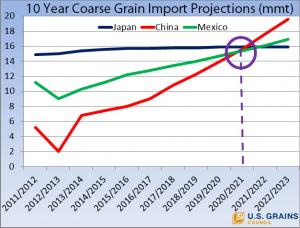This week’s U.S. Grains Council Chart of the Week shows import projections from the U.S. Department of Agriculture’s Economic Research Service (USDA ERS). Developing economies are surging demand for global grains. Japan has long held the title as the world’s largest coarse grain importer, led by world class infrastructure and robust corn imports. However, with a stagnant economy and aging population, recent data suggests they may not only lose the crown, but fall to third place amongst grain importers in less than ten years. As the global middle class starts to surface, consumers with more purchasing power transition from a plant starch based diet to a more animal protein based diet. Therefore, economic growth and meat consumption are directly correlated.
According to the baseline projections, USDA ERS forecasts that both China and Mexico will import roughly the same amount of coarse grain in 2021, with China quickly rocketing past the other two. Meanwhile, Mexico gradually surpasses Japan, quickly bumping the longtime king of global grain imports to third.
“Everyone is talking about the rapid growth of China, but we take for granted the development, evolution and sophistication in Mexico,” said Kevin Roepke, USGC manager of global trade. “Mexico seems to be the market nobody is talking about, but following China, they are the largest opportunity for growth. Plus, with infrastructure and inherent partnerships linked back to the United States, one can assume we will obtain an exceptionally large market share of Mexico’s incremental business.”
Coarse grains encompass corn, sorghum, barley, rye, millet and mixed grains, although corn is the dominant grain, accounting for 80 percent of the world coarse grain trade. Barley has the next largest share at 13 percent, followed by sorghum at 5 percent, according to USDA ERS analysis. Overall, world coarse grain trade is projected to increase 27 percent over the next decade.
The Council has been active in all three markets for more than 30 years and has developed many programs to facilitate the growth and development of the livestock and industrial sectors responsible for the tremendous growth in all arenas.


